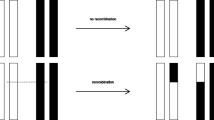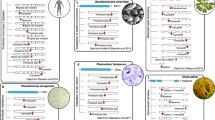Abstract
It is difficult to directly observe processes like natural selection at the genetic level, but relatively easy to estimate genetic frequencies in populations. As a result, genetic frequency data are widely used to make inferences about the underlying evolutionary processes. However, multiple processes can generate the same patterns of frequency data, making such inferences weak. By studying the limits to the underlying processes, one can make inferences from frequency data by asking how strong selection (or some other process of interest) would have to be to generate the observed pattern. Here we present results of a study of the limits to the relationship between selection and recombination in two-locus, two-allele systems in which we found the limiting relationships for over 30 000 sets of parameters, effectively covering the range of two-locus, two-allele problems. Our analysis relates T min—the minimum time for a population to evolve from the initial to the final conditions—to the strengths of selection and recombination, the amount of linkage disequilibrium, and the Nei distance between the initial and final conditions. T min can be large with either large disequilibrium and small Nei distance, or the reverse. The behavior of T min provides information about the limiting relationships between selection and recombination. Our methods allow evolutionary inferences from frequency data when deterministic processes like selection and recombination are operating; in this sense they complement methods based entirely on drift.
Similar content being viewed by others
References
Bonneuil, N. (1998). Population paths implied by the mean number of pairwise nucleotide differences among mitochondrial DNA sequences. Ann. Hum. Genet. 62, 61–73.
Bonneuil, N. and P. Saint-Pierre (2000). Protected polymorphism in the two-locus haploid model with unpredictable fitnesses. J. Math. Biol. 40, 251–277.
Brookes, M. I., Y. A. Graneau, P. King, O. C. Rose, C. D. Thomas and J. L. B. Mallet (1997). Genetic analysis of founder bottlenecks in the rare British butterfly Plebejus argus. Conserv. Biol. 11, 648–661.
Bryson, A. E. Jr and Y.-C. Ho (1975). Applied Optimal Control: Optimization, Estimation, and Control, Washington, DC: Hemisphere, p. 481.
Fox, G. A. and A. Hastings (1992). Inferring selective history from multilocus data sets: Wright meets the Hamiltonian. Genetics 132, 277–288.
Freund, R. J., R. C. Littell and P. C. Spector (1986). SAS System for Linear Models, Cary, NC: SAS Institute.
Fu, Y. X. and W. H. Li (1999). Coalescing into the 21st century: an overview and prospects of coalescent theory. Theor. Pop. Biol. 56, 1–10.
Gillespie, J. (1994). Alternatives to the neutral theory, in Non-neutral Evolution: Theories and Molecular Data, B. Golding (Ed.), New York: Chapman and Hall, pp. 1–17.
Hastings, A. (1981). Disequilibrium, selection, and recombination: limits in two-locus, two-allele models. Genetics 98, 659–668.
Hastings, A. (1990). The interaction between selection and linkage in plant populations, in Plant Population Genetics, Breeding, and Genetic Resources, A. H. D. Brown, M. T. Clegg, A. L. Kahler and B. S. Weir (Eds), Sunderland, MA: Sinauer Associates, pp. 163–180.
Hastings, A. and G. A. Fox (1995). Optimization as a way of studying population genetic equations, in Biocomputation—Evolution as a Computational Process, F. H. Eckman (Ed.), New York: Springer.
Kreitman, M. and R. R. Hudson (1991). Inferring the evolutionary histories of the Adh and Adh-dup loci in Drosophila melanogaster from patterns of polymorphism and divergence. Genetics 127, 565–582.
Nei, M. (1987). Molecular Evolutionary Genetics, New York: Columbia University Press, p. 512.
Pemberton, J. M., D. W. Coltman, J. A. Smith and J. G. Pilkington (1999). Molecular analysis of a fluctuating, promiscuous mating system. Biol. J. Linn. Soc. 68, 289–301.
Richman, A. D., M. K. Uyenoyama and J. R. Kohn (1996). Allelic diversity and gene genealogy at the self-incompatibility locus in the Solanaceae. Science 273, 1212–1216.
Author information
Authors and Affiliations
Rights and permissions
About this article
Cite this article
Fox, G.A., Hastings, A. Limiting relationships between selection and recombination. Bull. Math. Biol. 65, 129–141 (2003). https://doi.org/10.1006/bulm.2002.0324
Received:
Accepted:
Issue Date:
DOI: https://doi.org/10.1006/bulm.2002.0324




